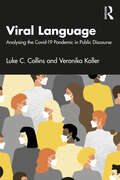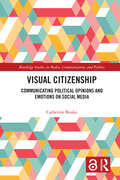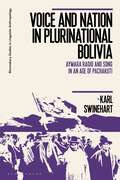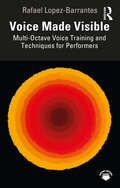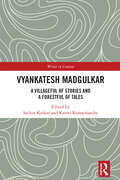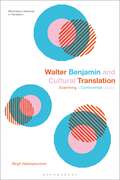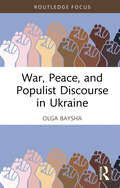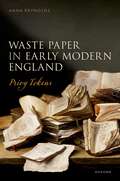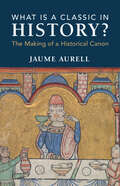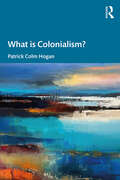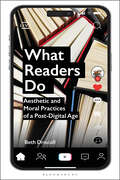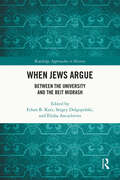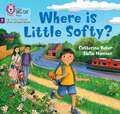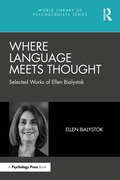- Table View
- List View
Viral Language: Analysing the Covid-19 Pandemic in Public Discourse
by Luke C. Collins Veronika KollerViral Language considers a range of different types of public communication and their discussion of the Covid-19 pandemic as a way to investigate health communication. The authors introduce and apply a range of approaches informed by linguistic theory to investigate experiences of the pandemic across a variety of public contexts. In doing so, they demonstrate how experiences of health and illness can be shaped by political messaging, scientific research, news articles and advertising. Through a series of case studies of Covid-related texts, the authors consider aspects of language instruction, information and innovation, showcasing the breadth of topics that can be studied as part of health communication. Furthermore, each case study provides practical guidance on how to carry out investigations using social media texts, how to analyse metaphor, how to track language innovation and how to work with text and images. Viral Language is critical reading for postgraduate and upper undergraduate students of applied linguistics and health communication.
Visions of Transmerica: Neobaroque Strategies of Nomadic Transgression (Literatures of the Americas)
by Krzysztof A. KulawikThis book looks at Neobaroque Latin American fiction, poetry, essay and performance from the 1970s to the early 2000s in order to explore the cultural hybridization and transgressive identity transformations at play in these works. It shows how the ornamental style and boldly experimental techniques are an effective strategy in presenting decentered identities in sexually ambiguous, multiethnic, interracial, transcultural, and mutant characters, as well as in metafictional narrators and authors. In this way, the book demonstrates the potential of Neobaroque works to destabilize normative, essentialist and binary categories of identity. The study focuses on Latin America as a cultural macroregion, drawing on examples from a variety of countries, including Argentina, Uruguay, Chile, Bolivia, Brazil, Cuba, Mexico, and the US-Mexican border. Drawing on gender, queer, trans and Chicana feminist theory, it argues for an alternative approach to a model of the Self, or a theory of selfhood, derived from the exuberant style and experimental techniques of the Neobaroque.
Visual Citizenship: Communicating political opinions and emotions on social media (Routledge Studies in Media, Communication, and Politics)
by Catherine BoukoThis book explores visual political engagement online – how citizens participate in the dynamism of life in society by expressing their opinions and emotions on various issues of democratic life in image-based social media posts, independently of collective actions.Looking beyond large digital social movements to focus on the everyday, the book provides a well-documented and comprehensive framework of key notions, concrete methods and examples of empirical insights into everyday visual citizenship on social media. It shows how the visual has become ubiquitous in citizens’ communication on social media, focusing on how citizens use visual content to express their emotions and opinions on social media platforms when they discuss politics in a large sense.With this book, every reader interested in political communication, visual communication and/or new media is fully equipped to analyse everyday visual citizenship on social media platforms.The Open Access version of this book, available at http://www.taylorfrancis.com, has been made available under a Creative Commons [Attribution-Non Commercial-No Derivatives (CC-BY-NC-ND)] 4.0 license.
Visual Citizenship: Communicating political opinions and emotions on social media (Routledge Studies in Media, Communication, and Politics)
by Catherine BoukoThis book explores visual political engagement online – how citizens participate in the dynamism of life in society by expressing their opinions and emotions on various issues of democratic life in image-based social media posts, independently of collective actions.Looking beyond large digital social movements to focus on the everyday, the book provides a well-documented and comprehensive framework of key notions, concrete methods and examples of empirical insights into everyday visual citizenship on social media. It shows how the visual has become ubiquitous in citizens’ communication on social media, focusing on how citizens use visual content to express their emotions and opinions on social media platforms when they discuss politics in a large sense.With this book, every reader interested in political communication, visual communication and/or new media is fully equipped to analyse everyday visual citizenship on social media platforms.The Open Access version of this book, available at http://www.taylorfrancis.com, has been made available under a Creative Commons [Attribution-Non Commercial-No Derivatives (CC-BY-NC-ND)] 4.0 license.
Vocabulary, Corpus and Language Teaching: A Machine-Generated Literature Overview
by Muthyala Udaya Chada Ramamuni ReddyThis book is the result of a collaboration between a human editor and an artificial intelligence algorithm to create a machine-generated literature overview of research articles analyzing the importance of ESL/EFL vocabulary and corpus studies. It is a new publication format in which state-of-the-art computer algorithms are applied to select the most relevant articles published in Springer Nature journals and create machine-generated literature reviews by arranging the selected articles in a topical order and creating short summaries of these articles.This comprehensive book explores ESL/EFL vocabulary and corpus studies from five main perspectives: acquisition, strategies, ICT, corpus, and current practices. The sections delve into topics such as the impact of technology on learning, the power of corpora in language education, and innovative vocabulary-development techniques.This book is an essential resource for researchers, educators, and language facilitators seeking a deeper understanding of vocabulary within ESL/EFL teaching and learning contexts.
Voice and Nation in Plurinational Bolivia: Aymara Radio and Song in an Age of Pachakuti (Bloomsbury Studies in Linguistic Anthropology)
by Karl SwinehartThis book offers ethnographic accounts of Aymara language media activism in Bolivia during the presidency of Evo Morales (2006–2019). It draws on research conducted among Aymara language radio broadcasters, hip hop artists, and community members during a period of radical social change and Indigenous political resurgence (pachakuti) in South America's most Indigenous republic. The Plurinational Republic of Bolivia counts Aymara among its official languages, but Aymara's social status and transmission to newer generations raise concerns about whether, despite being one of the most widely spoken Indigenous languages of the Americas, the threat of language obsolescence persists. This ethnographic account of Indigenous language activism shows how Aymara media and cultural workers combat this threat by making the language audible in diverse corners of Aymara life and examines the role Indigenous multilingualism plays in Bolivian politics. Through interviews and analysis of Aymara media texts, this study shows how language professionals determine how “the voice of the people” should sound. By introducing neologisms and archaicisms to avoid mixing Aymara with Spanish, Aymara language professionals disseminate a register of dehispanicized Aymara over the airwaves. The study reveals how these language professionals approach cultivating Aymara as more than a question of linguistic competence, but also of political commitment and anti-racist practice. Organized into two sections, one on radio and one on song, and including clear explanations and illustrations of key concepts in linguistic anthropology, this book listens to Aymara language advocacy from devout Catholics, union militants, and hip hop artists and fans, who hear in their language both the past and the future of Bolivia's Aymaras.
Voice Made Visible: Multi-Octave Voice Training and Techniques for Performers
by Rafael Lopez-BarrantesVoice Made Visible is an exploration of voice training and performance practice based on the use and application of Multi-Octave Vocal Range techniques. "Multi-Octave" is understood as the arsenal of sounds that exists uniquely within each human voice, beyond the comfortable average octave that we use in everyday life. In Voice Made Visible, Rafael Lopez-Barrantes builds on the voice work created by Alfred Wolfsohn and developed by Roy Hart and his company in France to assist students, artists, and those interested in the performing arts with their vocal practice. He draws from over three decades of multi-cultural performance and teaching, sharing the three fundamental pillars of his system: Fiction, News, and Body Source. This book will help readers unfold their understanding of the voice by strengthening it and inspire them to create new vocal paths for the stage, camera, and voice acting, as well as for their own personal expressive growth. Voice Made Visible is an invaluable resource for students of Acting and Voice courses, as well as working performing artists. For supplemental material, including pedagogical audio-visual clips, please visit www.barrantesvoicesystem.com.
Voice Made Visible: Multi-Octave Voice Training and Techniques for Performers
by Rafael Lopez-BarrantesVoice Made Visible is an exploration of voice training and performance practice based on the use and application of Multi-Octave Vocal Range techniques. "Multi-Octave" is understood as the arsenal of sounds that exists uniquely within each human voice, beyond the comfortable average octave that we use in everyday life. In Voice Made Visible, Rafael Lopez-Barrantes builds on the voice work created by Alfred Wolfsohn and developed by Roy Hart and his company in France to assist students, artists, and those interested in the performing arts with their vocal practice. He draws from over three decades of multi-cultural performance and teaching, sharing the three fundamental pillars of his system: Fiction, News, and Body Source. This book will help readers unfold their understanding of the voice by strengthening it and inspire them to create new vocal paths for the stage, camera, and voice acting, as well as for their own personal expressive growth. Voice Made Visible is an invaluable resource for students of Acting and Voice courses, as well as working performing artists. For supplemental material, including pedagogical audio-visual clips, please visit www.barrantesvoicesystem.com.
Vyankatesh Madgulkar: A Villageful of Stories and a Forestful of Tales (Writer in Context)
Vyankatesh Madgulkar (1927–2001) was one of the pioneers of modernist short fiction (nav katha) as well as ‘rural’ (grameen) fiction in Marathi in the post-World War II era. He wrote eight novels, two hundred short stories, several plays, including some notable ‘folk plays’ (loknatya), screenplays and dialogues for more than eighty Marathi films. This book offers a comprehensive understanding of Vyankatesh Madgulkar’s work by analysing selections from his major creative fictions and nonfictions. This is augmented with important writings on him by his contemporaries, as well as critical writings, commentaries and reviews by present-day scholars. It situates Madgulkar in the context of Marathi literary tradition and Indian literature in general.Part of the Writer in Context series, this book will be useful for scholars and researchers of Indian literature, Marathi literature, English literature, comparative literature, postcolonial studies, cultural studies, global south studies and translation studies.
Vyankatesh Madgulkar: A Villageful of Stories and a Forestful of Tales (Writer in Context)
by Sachin Ketkar Keerti RamachandraVyankatesh Madgulkar (1927–2001) was one of the pioneers of modernist short fiction (nav katha) as well as ‘rural’ (grameen) fiction in Marathi in the post-World War II era. He wrote eight novels, two hundred short stories, several plays, including some notable ‘folk plays’ (loknatya), screenplays and dialogues for more than eighty Marathi films. This book offers a comprehensive understanding of Vyankatesh Madgulkar’s work by analysing selections from his major creative fictions and nonfictions. This is augmented with important writings on him by his contemporaries, as well as critical writings, commentaries and reviews by present-day scholars. It situates Madgulkar in the context of Marathi literary tradition and Indian literature in general.Part of the Writer in Context series, this book will be useful for scholars and researchers of Indian literature, Marathi literature, English literature, comparative literature, postcolonial studies, cultural studies, global south studies and translation studies.
Walter Benjamin and Cultural Translation: Examining a Controversial Legacy (Bloomsbury Advances in Translation)
by Birgit HaberpeuntnerDissecting the radical impact of Walter Benjamin on contemporary cultural, postcolonial and translation theory, this book investigates the translation and reception of Benjamin's most famous text about translation, “The Task of the Translator,” in English language debates around 'cultural translation'. For years now, there has been a pronounced interest in translation throughout the Humanities, which has come with an increasing detachment of translation from linguistic-textual parameters. It has generated a broad spectrum of discussions subsumed under the heading of 'cultural translation', a concept that is constantly re-invented and manifests in often heavily diverging expressions. However, there seems to be a distinct constant: In their own (re-)formulations of this concept, a remarkable number of scholars-Bhabha, Chow, Niranjana, to name but a few-explicitly refer to Walter Benjamin's “The Task of the Translator.” In its first part, this book considers Benjamin and the way in which he thought about, theorized and practiced translation throughout his writings. In a second part, Walter Benjamin meets 'cultural translation': tracing various paths of translation and reception, this part also tackles the issues and debates that result from the omnipresence of Walter Benjamin in contemporary theories and discussions of 'cultural translation'. The result is a clearer picture of the translation and reception processes that have generated the immense impact of Benjamin on contemporary cultural theory, as well as new perspectives for a way of reading that re-shapes the canonized texts themselves and holds the potential of disturbing, shifting and enriching their more 'traditional' readings.
War, Peace, and Populist Discourse in Ukraine (Routledge Focus on Communication Studies)
by Olga BayshaThis book explores the detrimental effects on global peace of populism’s tendency to present complex social issues in simplistic "good versus evil" terms. Analyzing the civilizational discourse of Ukrainian President Volodymyr Zelensky with respect to the ongoing war between Russia and Ukraine—with his division of the world into "civilized us" versus "barbarian them"—the book argues that such a one-dimensional representation of complex social reality leaves no space for understanding the conflict and has little, if any, potential to bring about peace.To deconstruct the "civilization versus barbarism" discourse propagated by Zelensky, the book incorporates into its analysis alternative articulations of the crisis by oppositional voices. The author looks at the writing of several popular Ukrainian journalists and bloggers who have been excluded from the field of political representation within Ukraine, where all oppositional media are currently banned. Drawing on the discourse theory of Ernesto Laclau and Chantal Mouffe, the author argues that the incorporation of alternative perspectives, and silenced voices, is vitally important for understanding the complexity of all international conflicts, including the current one between Russia and Ukraine.This timely and important study will be relevant for all students and scholars of media and communication studies, populist rhetoric, political communication, journalism, area studies, international relations, linguistics, discourse analysis, propaganda, and peace studies.
War, Peace, and Populist Discourse in Ukraine (Routledge Focus on Communication Studies)
by Olga BayshaThis book explores the detrimental effects on global peace of populism’s tendency to present complex social issues in simplistic "good versus evil" terms. Analyzing the civilizational discourse of Ukrainian President Volodymyr Zelensky with respect to the ongoing war between Russia and Ukraine—with his division of the world into "civilized us" versus "barbarian them"—the book argues that such a one-dimensional representation of complex social reality leaves no space for understanding the conflict and has little, if any, potential to bring about peace.To deconstruct the "civilization versus barbarism" discourse propagated by Zelensky, the book incorporates into its analysis alternative articulations of the crisis by oppositional voices. The author looks at the writing of several popular Ukrainian journalists and bloggers who have been excluded from the field of political representation within Ukraine, where all oppositional media are currently banned. Drawing on the discourse theory of Ernesto Laclau and Chantal Mouffe, the author argues that the incorporation of alternative perspectives, and silenced voices, is vitally important for understanding the complexity of all international conflicts, including the current one between Russia and Ukraine.This timely and important study will be relevant for all students and scholars of media and communication studies, populist rhetoric, political communication, journalism, area studies, international relations, linguistics, discourse analysis, propaganda, and peace studies.
Waste Paper in Early Modern England: Privy Tokens
by Anna ReynoldsThe ubiquity of waste paper in early modern England has long been misunderstood. Though insults and modesty tropes that refer to waste paper are widespread, these have often been dismissed as nothing more than rhetorical flourishes. Paired with the common misconception that paper would have been too valuable to 'waste' in the sixteenth and seventeenth centuries, these tropes have been read as scatological flights of fancy. Waste Paper in Early Modern England argues that such commonplaces are in fact indicative of everyday, material experience - of an author's, reader's, housewife's, or city-dweller's immersion in an environment brimming with repurposed scraps and sheets. It demonstrates that waste paper makes visible a radically different understanding of waste matter in the early modern period than in our own. More than a rhetorical aside, repurposed pages were both materially and figuratively useful. Drawing on a range of literary, pictorial, and bibliographical sources, Waste Paper in Early Modern England reveals how layers of meaning accreted around paper fragments in the sixteenth and seventeenth centuries, and how, because of the widespread sensitivity to the life cycle of paper and books, wasted pages prompted meaningful imaginative work. The book's five chapters recount how, in this period, the biography of waste paper provided a thing to think with concerning matter and temporality - a potent and flexible emblem for the troublesome passage of books and all other sorts of bodies through time.
We Can Cook: Phase 3 Set 2 (Big Cat Phonics For Little Wandle Letters And Sounds Revised Ser.)
by Sophia Payne Sayada Ramdial Collins Big CatWhat Ho! P. G. Wodehouse on Hollywood (What Ho! P. G. Wodehouse)
by Paul Kent"It isn't half such a crazy place as it's made out to be. I know two- three people in Hollywood that are part sane." A talking gorilla called Cyril who graduated from Oxford University; a sword-wielding diva driven crazy by her orange juice diet; an English milord swapping bodies with a gobby 12 year-old film star – these are screwball plots even by P. G. 'Plum' Wodehouse's brilliant comic standards. But not so surprising when we learn they take place in "the weirdest place" he had ever worked – Hollywood. Paul Kent's eighth essay on matters Wodehousean is a backstage pass to "Dottyville-on-the-Pacific's" Golden Age in the 1930's, replete with glamour, glitter and the monstrous egos of its biggest movers and shakers. You'll be SHOCKED! You'll be THRILLED! – but above all, you'll be ENTERTAINED!
What Is a Classic in History?: The Making of a Historical Canon
by null Jaume AurellWhat is a classic in historical writing? How do we explain the continued interest in certain historical texts, even when their accounts and interpretations of particular periods have been displaced or revised by newer generations of historians? How do these texts help to maintain the historiographical canon? Jaume Aurell's innovative study ranges from the heroic writings of ancient Greek historians such as Herodotus to the twentieth century microhistories of Carlo Ginzburg. The book explores how certain texts have been able to stand the test of time, gain their status as historiographical classics, and capture the imaginations of readers across generations. Investigating the processes of permanence and change in both historiography and history, Aurell further examines the creation of historical genres and canons. Taking influence from methodologies including sociology, literary criticism, theology, and postcolonial studies, What Is a Classic in History? encourages readers to re-evaluate their ideas of history and historiography alike.
What is Colonialism?
by Patrick Colm HoganWhat is Colonialism? develops a clear and rigorous account of what colonialism is and how it works. It draws on and synthesizes recent work in cognitive science, affective science, and social psychology, along with Marxism and related forms of analysis. Hogan begins with some fundamental conceptual distinctions, such as the degree to which a group shares beliefs, dispositions, and skills versus the degree to which they share identification with a category. Building on these distinctions, he defines colonialism in terms of political, economic, and cultural autonomy, clarifying the nature of culture and autonomy particularly. He goes on to articulate an invaluable systematic account of the varieties of colonialism. The final chapters outline the motives of imperialists, differentiating these from their ideological rationalizations, and sketching the harms caused by colonialism. The book concludes by considering when, or if, one can achieve a genuinely postcolonial condition. Hogan illustrates these analyses by examining influential literary works—by European writers (such as Joseph Conrad) and by non-Europeans (such as Athol Fugard, Kamala Markandaya, and Wole Soyinka). This accessible and informative volume is the ideal resource for students and scholars interested in colonialism and empire.
What is Colonialism?
by Patrick Colm HoganWhat is Colonialism? develops a clear and rigorous account of what colonialism is and how it works. It draws on and synthesizes recent work in cognitive science, affective science, and social psychology, along with Marxism and related forms of analysis. Hogan begins with some fundamental conceptual distinctions, such as the degree to which a group shares beliefs, dispositions, and skills versus the degree to which they share identification with a category. Building on these distinctions, he defines colonialism in terms of political, economic, and cultural autonomy, clarifying the nature of culture and autonomy particularly. He goes on to articulate an invaluable systematic account of the varieties of colonialism. The final chapters outline the motives of imperialists, differentiating these from their ideological rationalizations, and sketching the harms caused by colonialism. The book concludes by considering when, or if, one can achieve a genuinely postcolonial condition. Hogan illustrates these analyses by examining influential literary works—by European writers (such as Joseph Conrad) and by non-Europeans (such as Athol Fugard, Kamala Markandaya, and Wole Soyinka). This accessible and informative volume is the ideal resource for students and scholars interested in colonialism and empire.
What Readers Do: Aesthetic and Moral Practices of a Post-Digital Age
by Dr Beth DriscollShining a spotlight on everyday readers of the 21st century, Beth Driscoll explores how contemporary readers of Anglophone fiction interact with the book industry, digital environments, and each other.We live in an era when book clubs, bibliomemoirs, Bookstagram and BookTok are as valuable to some readers as solitary reading moments. The product of nearly two decades of qualitative research into readers and reading culture, What Readers Do examines reading through three dimensions - aesthetic conduct, moral conduct, and self-care – to show how readers intertwine private and social behaviors, and both reinforce and oppose the structures of capitalism. Analyzing reading as a post-digital practice that is a synthesis of both print and digital modes and on- and offline behaviors, Driscoll presents a methodology for studying readers that connects book history, literary studies, sociology, and actor-network theory. Arguing for the vitality, agency, and creativity of readers, this book sheds light on how we read now - and on how much more readers do than just read.
When Jews Argue: Between the University and the Beit Midrash (Routledge Approaches to History)
This book re-thinks the relationship between the world of the traditional Jewish study hall (the Beit Midrash) and the academy: Can these two institutions overcome their vast differences? Should they attempt to do so? If not, what could two methods of study seen as diametrically opposed possibly learn from one another? How might they help each other reconceive their interrelationship, themselves, and the broader study of Jews and Judaism? This book begins with three distinct approaches to these challenges. The chapters then follow the approaches through an interdisciplinary series of pioneering case studies that reassess a range of topics including religion and pluralism in Jewish education; pain, sexual consent, and ethics in the Talmud; the place of reason and devotion among Jewish thinkers as diverse as Moses Mendelssohn, Jacob Taubes, Sarah Schenirer, Ibn Chiquitilla, Yair Ḥayim Bacharach, and the Rav Shagar; and Jewish law as a response to the post-Holocaust landscape. The authors are scholars of rabbinics, history, linguistics, philosophy, law, and education, many of whom also have traditional religious training or ordination. The result is a book designed for learned scholars, non-specialists, and students of varying backgrounds, and one that is sure to spark debate in the university, the Beit Midrash, and far beyond.
When Jews Argue: Between the University and the Beit Midrash (Routledge Approaches to History)
by Ethan B. Katz Sergey Dolgopolski Elisha AncselovitsThis book re-thinks the relationship between the world of the traditional Jewish study hall (the Beit Midrash) and the academy: Can these two institutions overcome their vast differences? Should they attempt to do so? If not, what could two methods of study seen as diametrically opposed possibly learn from one another? How might they help each other reconceive their interrelationship, themselves, and the broader study of Jews and Judaism? This book begins with three distinct approaches to these challenges. The chapters then follow the approaches through an interdisciplinary series of pioneering case studies that reassess a range of topics including religion and pluralism in Jewish education; pain, sexual consent, and ethics in the Talmud; the place of reason and devotion among Jewish thinkers as diverse as Moses Mendelssohn, Jacob Taubes, Sarah Schenirer, Ibn Chiquitilla, Yair Ḥayim Bacharach, and the Rav Shagar; and Jewish law as a response to the post-Holocaust landscape. The authors are scholars of rabbinics, history, linguistics, philosophy, law, and education, many of whom also have traditional religious training or ordination. The result is a book designed for learned scholars, non-specialists, and students of varying backgrounds, and one that is sure to spark debate in the university, the Beit Midrash, and far beyond.
Where Language Meets Thought: Selected Works of Ellen Bialystok (World Library of Psychologists)
by Ellen BialystokIn the World Library of Psychologists series, international experts present career-long collections of what they judge to be their most interesting publications – extracts from books, key articles, research findings, and practical and theoretical contributions.Ellen Bialystok has published widely in the field of cognitive development and decline across the lifespan. Her research uses behavioral and neuroimaging methods to examine the effect of experience on cognitive and brain systems with a focus on bilingualism. Her discoveries include the identification of differences in the development of cognitive and language abilities for monolingual and bilingual children, the use of different brain networks by monolingual and bilingual young adults performing cognitive tasks, and the postponement of symptoms of dementia in bilingual older adults. In other studies, she has investigated the effects of bilingual education on children’s development and the cognitive and brain consequences of bilingualism in older adults.Including a specially written introduction, in which Ellen Bialystok reflects on the role that language plays on thought, this collection will serve as a valuable resource for students and researchers of psycholinguistics, developmental psychology, and applied linguistics.
Where Language Meets Thought: Selected Works of Ellen Bialystok (World Library of Psychologists)
by Ellen BialystokIn the World Library of Psychologists series, international experts present career-long collections of what they judge to be their most interesting publications – extracts from books, key articles, research findings, and practical and theoretical contributions.Ellen Bialystok has published widely in the field of cognitive development and decline across the lifespan. Her research uses behavioral and neuroimaging methods to examine the effect of experience on cognitive and brain systems with a focus on bilingualism. Her discoveries include the identification of differences in the development of cognitive and language abilities for monolingual and bilingual children, the use of different brain networks by monolingual and bilingual young adults performing cognitive tasks, and the postponement of symptoms of dementia in bilingual older adults. In other studies, she has investigated the effects of bilingual education on children’s development and the cognitive and brain consequences of bilingualism in older adults.Including a specially written introduction, in which Ellen Bialystok reflects on the role that language plays on thought, this collection will serve as a valuable resource for students and researchers of psycholinguistics, developmental psychology, and applied linguistics.
